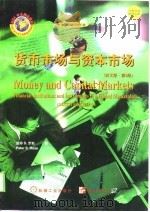《货币市场与资本市场》
| 作者 | 彼得 S·罗斯著 编者 |
|---|---|
| 出版 | 北京:机械工业出版社 |
| 参考页数 | 722 |
| 出版时间 | 1998(求助前请核对) 目录预览 |
| ISBN号 | 7111064100 — 求助条款 |
| PDF编号 | 86579118(仅供预览,未存储实际文件) |
| 求助格式 | 扫描PDF(若分多册发行,每次仅能受理1册) |

Contents1
Part One The Financial System in Perspective1
Chapter One The Role of the Financial Svstem in the Global Economy1
The Economy and the Financial System2
Flows within the Economy System2
The Role of Markets in the Economic System2
Types of Markets3
The Financial Markets and the Financial3
System Channel for Sarings and Inrestmem3
Functions Performed by the Financial System and the Financial Markets5
Sarings Function6
Wealth Function6
Liquidity Function7
Credit Function7
Payments Function7
Risk Function8
Policy Function8
Types of Financial Markets within the Financial System9
The Money Market versus the Capital Market9
Divisions of the Money and Capital Markets11
Open versus Negotiated Markets12
Primary versus Secondary Markets12
Spot versus Futures.Forward. and Option Markets14
Factors Tying All Financial Markets Together15
The Dynamic Financial System17
The Plan of This Book17
Key Terms and Concepts in This Chapter19
Study Questions19
Problems20
Selected References22
Chapter Two Financial Assets, Money, and Financial Transactions23
The Creation of Financial Assets24
Characteristics of Financial Assets24
Different Kinds of Financial Assets24
The Creation Process for Financial Assets25
Financial Assets and the Financial System27
Lending and Borrowing in the Financial System29
Money as a Financial Asset31
What is Money?31
The Functions of Money31
The Evolution of Financial Transactions34
Direct Finance34
Semidirect finance35
Indirect Finance35
Relative Size and Importance of Major Financial Institutions37
Classification of Financial Institutions38
Portfolio Decisions by Financial Intermediaries and Other Financial Institutions39
Disintermediation of Funds39
New types of Disintermediation40
Summary41
Key Terms and Concepts in This Chapter41
Study Questions41
Problems42
Selected References43
Chapter Three Sources of Information for Financial Decision Making in the Money and Capital Markets44
Efficient Markets and Asymmetric information45
The Efficient Markets Hypothesis45
The Concept of symmetric Information48
Problems Informational Asymmetries Can Create:Lemons and Plums49
Problems Asymmetries Can create:The Problem of Adverse Selection50
Debt Security Prices and Yields53
Stock Prices and Dividend Yields56
Information on Security Issuers59
General Economic and Financial Conditions64
Social Accounting Data66
National Income Accounts66
The Flow of Funds Accounts67
Summary78
Key Terms and Concepts in This Chapter79
Study Questions79
Problems79
Selected References81
Part TWO The Management and Regulation of Financial Institutions81
Chapter Four The Commercial Banking Industry82
The Structure of U.S. Commercial Banking83
A Trend Ioward Consolidation84
Branch Banking84
Bank Holding Companies85
International Banking86
Bank Failures87
Changing Technology88
Portfolio Characteristics of Commercial Banks89
Cash and Due from Banks Primary Reserves89
Security Holdings and Secondary Reserves92
Loans92
Deposits93
Nondeposit Sources of Funds94
Equity Capital95
Revenues and Expenses95
Money Creation and Destruction by Banks98
Reserve Requirements and Excess Reserves98
The Creation if Money and Credit100
Destruction of Deposits and Reserves104
Implications of Money Creation and Destruction105
Summary105
Key Terms and Concepts in This Chapter105
Study Questions105
Problems106
Selected References107
Chapter Five Nonbank Thrift Institutions: Credit Unions,Savings and Loan Associations, Savings Banks, and Money Market Mutual Funds109
Credit Unions110
Credit Union Membership111
Size of Credit Unions111
New Services Offered112
A Strong Competitive Force113
Savings and Loan Associations113
Origins113
How Funds Are Raised and Allocated114
Trends in Revenues and Costs116
Possible Remedies for the Industry's Problems120
Savings Banks120
Number and Distribution of Savings Banks121
How Funds Are Raised and Allocated121
Current Trends and Future Problems122
Money Market Funds122
Summary129
Key Terms and Concepts in This Chapter129
Study Questions129
Problems130
Selected References131
Chapter Six Insurance Companies. Pension Funds, and Other Financial Institutions132
Life Insurance Companies132
The Insurance Principle133
Investments of Life Insurance Companies133
Sources of Life Insurance Company Funds137
Structure and Growth of the Life Insurance Industry137
New Services137
Property-Casualty Insurance Companies140
Makeup of the Property-Casualty (P/C) Insurance Industry140
Changing Risk Patterns in Property/Liability Coverage140
Investments by Property-Casualty (P/C) Companies141
Sources of income142
Business Cycles,Inflation,and Competition142
Pension Funds143
Growth of Pension Funds144
Investment Strategies of Pension Funds146
Pension Fund Assets147
Factors Affecting the Future Growth of Pension Funds147
Finance Companies149
Different Finance Companies for Different Purposes150
Growth of Finance Companies150
Methods of Industry Financing151
Recent Changes in the Character of the Finance Company Industry152
Investment Companies152
The Background of Investment Companies152
Tax Status of the Industry154
Open-End and Closed-End Investment Companies154
Goals and Earnings of Investment Companies155
Other FinanciaI Institutions156
Trends Affecting All Financial Institutions Today160
Summary161
Key Terms and Concepts in This Chapter162
Study Questions162
Problems162
Selected References163
Chapter Seven The Regulation of Financial Institutions164
The Reasons behind the Regulation of Financial Institutions165
Does Regulation Benefit or Harm Financial Institutions?166
The Regulation of Commercial Banks167
The Federal Reserve System168
The Comptroller of the Currency168
Federal Deposit lnsurance Corporation168
State Banking Commissions170
Regulations Controlling the Geographic Expansion of Banks170
Regulation of the Services Banks Can Offer174
The Rise of Disclosure Laws in Banking176
The Growing Importance of Capital Regulation in Banking176
The Unfinished Agenda for Banking Regulation178
The Regulation of Nonbank Thrift Institutions180
Credit Unions180
Savings and Loans181
Savings Banks185
Money Market Funds185
The Regulation of lnsurance Companies186
The Regulation of Pension Funds186
The Regulation of Finance Companies187
The Regulation of Investment Companies187
An Overview of Trends in the Regulation of Financial Institutions188
Key Terms and Concepts in This Chapter190
Study Questions191
Problems191
Selected References191
Part Three Interest Rates and Security Prices191
Chapter Eight Interest Rates in the Financial System192
Functions of the Rate of Interest in the Economy193
The Classical Theory of Interest Rates193
Saving by Households194
Saving by Business Firms194
Saving by Government195
The Demand for Investment Funds195
The Equilibrium Rate of Interest in the Classical Theory of Interest198
Limitarions of the Classical Theory of Interest200
The Liquidity Preference Theory200
The Demand for Liquidity200
The Supply of Money202
The Equitibrium Rate of Interest in Liquidity Preference Theory203
Limitations of the Liquidity Preference Theory204
The Loanable Funds Theory205
Consumer Demand for Loanable Funds205
Domestic Business Demand for Loanable Funds205
Government Demand for Loanable Funds205
Foreign Demand for Lounable Funds206
Total Demand for Loanable Funds206
The Supply of Loanable Funds206
Total Supply of Loanable Funds208
The Equilibrium Rate of Interest in the Loanable Funds Theory208
The Rational Expectations Theory211
Summary215
Key Terms and Concepts in This Chapter216
Study Questions216
Problems217
Selected References218
Chapter Nine Relationships between Interest Rates and Security Prices219
Units of Measurement for lnterest Rates and Security Prices219
Definition of Interest Rates219
Basis Points220
Security Prices220
Measures of the Rate of Return,or Yield, on a Loan or Security221
Coupon Rate221
Current Yield222
Yield to Maturity222
Holding-Period Yield223
Calculating Yields to Maturity and Holding-Period Yields224
Yield-Price Relationships227
Interest Rates Charged by Institutional Lenders229
The Simple Interest Method230
Add-On Rate of Interest230
Discount Method231
Home Mortgage Interest Rate231
Annual Percentage Rate(APR)232
Compound Interest233
The Annual Percentage Yield(APY)235
Summary236
Key Terms and Concepts in This Chapter236
Study Questions236
Problems237
Selected References238
Chapter Ten Inflation, Yield Curves, and Duration239
Inflation and Interest Rates240
The Correlation between Inflation and Interest Rates240
The Nominal and Real Interest Rates240
The Fisher Effect241
The Harrod-Keynes Effect Of Inflation242
Alternative Views on Inflation and Interest Rates243
Inflation and Stock Prices248
The Maturity of a Loan250
The Yield Curve and the Term Structure of Interest Rates250
Types of Yield Curves250
The Unbiased Expectations Hypothesis251
The Role of Expectations in Shaping the Yield Curve253
Relative Changes in Long-Term Interest Rates253
Policy Implications of the Unbiased Expectations Hypothesis254
The Liquidity Premium View Of the Yield Curve255
The Segmented-Markets or Hedging-Pressure Argument255
Policy implications of the Segmented-Markets Theory256
The Preferred Habitat or Composite Theory of the Yield Curve257
Research Evidence on Yield-Curve258
Theories258
Uses of the Yield Curve261
Duration: A Different Approach to Maturity262
The Price Elasticity of a Debt Security262
The Impact of Varying Coupon Rates263
An Alternative Maturity Index for a Security:Duration264
Uses of Duration265
Limitations of Duration267
Summary268
Key Terms and Concepts in This Chapter269
Study Questions269
Problems270
Selected References271
Chapter Eleven Default Risk, Taxes, and Other Factors Affecting Interest Rates273
Marketability274
Liquidity274
Default Risk and Interest Rates275
The Premium for Default Risk275
The Expected Rate of Return or Yield on a Risky Security276
AnticiPated Loss and Default-Risk Premiums276
Factors Influencing Default-Risk Premiums277
The Rise and Fall of Junk Bonds283
A Summary of the Default Risk, Interest Rate Relationship284
Call Privileges284
Calculating the Yields on Called Securities284
Advantages and Disadvantages of the Call Privilege287
The Call Premium and Interest Rate Expectations287
Research Evidence288
Effect of Coupon Rates on Call Risk288
Prepayment Risk and Interest Rates on Loan-Backed Securities289
Taxation of Security Returns290
The Tax Treatment of Capital Gains290
Treatment of Capital Losses292
Tax-Exempt Securities292
Convertible Securities294
The Structure of Interest Rates295
Key Terms and Concepts in This Chapter296
Study Questions296
Problems297
Selected References298
Chapter Twelve Interest Rate Forecasting and Hedging against Interest Rate Risk299
The Influence of the Business Cycle in Shaping Interest Rates300
Relative Movements in Short-and Long-Term Interest Rates and Security Prices over the Business Cycle301
Seasonality302
Forecasting Interest Rates: Advantages and Problems303
Advantages of Rate Forecasting303
Problems in Forecasting Interest Rates303
Approaches to Modem Interest Rate Forecasting304
Money Supply APProaches304
Inflation and the Fisher Effect305
Econometric Models306
The Flow of Funds Accounts as a Source of Forecasting Information307
Following the Forward Calendar of New Security Offerings308
Market Expectations and Implied Rate Forecasting308
The Consensus Forecast310
Interest-Rate-Risk Hedging Strategies310
Duration310
Stripped Securities311
GAP Management312
Interest Rate Caps and Collars313
Interest Rate Insurance313
Loan Options314
Interest Rate SWAPS314
Summary318
Key Terms and Concepts in This Chapter319
Study Questions319
Problems320
Selected References321
Chapter Thirteen FinanciaI Futures and Options Contracts323
The Nature of Futures Trading323
General Principles of Hedging324
Opening and Closing a Hedge324
Why Hedging Can Be Effective325
Risk Selection through Hedging326
FinanciaI Futures326
The Purpose of Trading in Financial Futures327
Securities Used in Financial Futures Contracts328
U.S. Treasury Bonds and Notes329
U.S. Treasury Bills330
Eurodollar Time Deposits331
Other Money Market Futures Contracts331
Municipal State and Local Government Bonds331
New Foreign-Bond-Index Futures Contracts331
Stock Index Futures332
Types of Hedging in the Financial Futures Market333
The Long (or Buying) Hedge333
The Short (or Selling)Hedge334
Cross Hedging335
The Mechanics of Futures Trading336
Payoff Diagrams for Long and Short Futures Contracts338
Options Contracts on Financial Futures339
Basic Types of Option Contracts339
Option Contracts for Money Market and Capital Market Instruments340
Uses of Options on futures Contracts341
Payoff Diagrams for Valuing Options343
The Black-Scholes Model for Valuing Options347
Traders Active in the Futures and Options Markets348
Potential Benefits from the Futures and Options Markets349
Summary352
Key Terms and Concepts in This Chapter353
Study Questions353
Problems354
Selected References355
Part Four The Money Market356
Chapter Fourteen Characteristics of the Money Market356
Characteristics of the Money Market357
The Need for a Money Market357
Borrowers and Lenders in the Money Market358
The Goals of Money Market Investors358
Types of Investment Risk359
Money Market Maturities360
Depth and Breadth of the Money Market360
Federal funds versus Clearinghouse Funds361
A Market for Large Borrowers and Lenders361
The Volume of Money Market Securities363
The Pattern of Interest Rates in the Money Market364
Summary366
Key Terms and Concepts in This Chapter367
Study Questions367
Problems367
Selected References368
Chapter Fifteen Treasury Bills, Dealer Loans, and Repurchase Agreements369
U.S. Treasury Bills370
Volume of Bills Outstanding370
Types of Treasury Bills371
How Bills Are Sold371
Results of a Recent Bill Auction372
Calculating the Yield on Bills373
Market Interest Rates on Treasury Bills375
Investors in Treasury Bills377
Primary Dealers, Dealer Loans, and Repurchase Agreements378
Scandal Rocks the Market for Government Securities378
Proposals for New Ways to Auction Government Securities379
Dealers Reliance on Borrowed Funds381
Demand Loans381
Repurchase Agreements381
Sources of Dealer Income383
Dealer positions in Securities384
Changing Sources of Dealer Financing385
Dealer Transactions and Government Security Brokers385
Summary386
Key Terms and Concepts in This Chapter387
Study Questions387
Problems387
Selected References388
Chapter Sixteen Federal Funds, Negotiable CDs, and Loans from the Discount Window389
Federal Funds390
Nature of Federal Funds390
Use of the Federal Funds Market to Meet Deposit Reserve Requirements391
Mechanics of Federal Funds Trading392
Volume of Borrowings in the Funds Market393
Rates on Federal Funds393
Federal Funds and Government Policy394
Negotiable Certificates of Deposit394
Growth of CDs396
Terms Attached to CDs396
Buyers of CDs397
Cds in Liability Management398
New Types of CDs398
Loans from the Federal Reserve's Discount Window400
Causes and Effects of Borrowing from the Discount Window400
Collateral for Discount Window Loans401
Restrictions on Federal Reserve Credit401
The Federal Reserve's Discount Rate402
Concluding Comment on Bank Activity in the Money Market404
Key Terms and Concepts in This Chapter405
Study Questions405
Problems406
Selected References406
Chapter Seventeen Commercial Paper and Federal Agency Securities407
Commercial Paper408
What Is Commercial PaPer?408
Types of Commercial Paper408
Recent Growth Of Commercial PaPer410
Maturities and Rates of Return on Commercial PaPer413
Changing Yields on PaPer Issues413
Advantages of Issuing Commercial PaPer414
Possible Disadvantages from Issuing Commercial PaPer415
Principal investors415
Continuing Innovation in the PaPer Market416
Commercial PaPer Ratings417
Dealers in PaPer418
Federal Agency Securities418
Types of Federal Credit Agencies419
Growth Of the Agency Market420
Terms on Agency Securities421
The Marketing Of Agency Issues422
Summary423
Key Terms and Concepts in This Chapter423
Study Questions424
Problems424
Selected References425
Chapter Eighteen International Money Market Instruments:Bankers' Acceptances and Eurodollars426
Bankers' Acceptances427
Why AccePtances Are Used in International Trade427
How AccePtances Arise428
Recent Growth of Acceptance Financing429
Acceptance Rates431
Investors in Acceptances432
Eurodollars432
What is a Eurodollar?433
The Creation of Eurodollars433
Eurodollar Maturities and Risks436
The Supply of Eurodollars437
Eurodollars in Domestic Bank Operations437
Recent Innovations in the Eurodollar Market439
Benefits and Costs of the Eurodollar Market439
Summary440
Key Terms and Concepts in This Chapter441
Study Questions441
Problems441
Selected References442
Part Five443
Central Banking and Monetary Policy443
Chapter Nineteen Central Banking and the Role of the Federal Reserve443
The Role of Central Banks in the Economy444
Control of the Money Supply444
Stabilizing the Money and Capital Markets444
Lender of Last Resort445
Maintaining and Improving the Payments Mechanism445
The Goals and Channels of Central Banking445
The Channels through Which Central Banks Work446
The History of the Federal Reserve System447
Problems in the Early U.S. Banking System449
Creation of the Federal Reserve System450
The Early Structure of the Federal Reserve System451
Goals and Policy Tools of the Federal Reserve System451
How the Fed is Organized452
Board of Governors of the Federal Reserve System452
The Federal Open Market Committee and Manager of the System Open Market Account453
The Federal Reserve Banks454
The Member Banks of the Federal Reserve System455
Roles of the Federal Reserve System Today458
The Clearing and Collection of Checks and Other Means of Payment458
Issuing Currency and Com and Providing Other Services459
Maintaining a Sound Banking and Financial system459
Serving as the Federal Governments Fiscal Agent460
Carrying out Monetary Policy460
Providing information to the Public460
Summary460
Key Terms and Concepts in This Chapter461
Study Questions462
Selected References462
Chapter Twenty The Tools of Monetary Policy463
Reserves and Money—Targets of Federal Reserve Policy463
The Composition of Reserves464
The Deposit Multiplier464
The Money Multiplier466
General versus Selective Credit Controls468
The General Credit Controls of the Fed468
Reserve Reauirements468
Changes in the Federal Reserves Discount Rate471
Open Market Operations474
Selective Credit Controls Used by the Fed481
Moral Suasion by Federal Reserve Officials483
Margin Requirements483
Summary484
Key Terms and Concepts in This Chapter485
Study Questions485
Problems485
Selected References486
Chapter Twenty-One Indicators and Goals of Monetary Policy487
Factors Influencing the Reserves of the Banking System488
Actions of the Public Affecting Reserves488
Operations of the Treasury and Foreign Investors Affecting Reserves489
Federal Reserve Operations Affecting reserves490
The Heart of The Monetary Policy Process Controlling Reserves to Achieve Desired Target Levels490
The Federal Reserve Statement490
Factors Supplying Reserves491
Factors Absorbing Reserves492
Measures of the Money Supply492
Money Supply Measures493
Federal Reserve Control of Money Supply Growth494
Achieving the Fed's Money Supply Targets496
Money Market Indicators496
The Federal Funds Rate497
Other Money Market Interest Rates498
Free Reserves498
The Federal Reserve and Economic Goals500
The Goal of Controlling Inflation500
The Goal of Full Employment501
The Goal of Sustainable Economic Growth503
Equilibrium in the U.s.Balance of Payments and Protecting the Dollar504
What Policies Should We Pursue to Achieve National and International Economic Goals?505
Monetarist View505
The Credit Availability,or Neo-Keynesian View506
Supply Side Economics508
The Trade-Offs among Economic Goals509
The Limitations of Monetary Policy510
Key Terms and Concepts in This Chapter510
Study Questions510
Problems511
Selected References511
Part Six513
The Roles Played by Governments within the Financial System513
Chapter Twenty-Two The Treasury in the Financial Markets513
The Fiscal Policy Activities of the U.S.Treasury513
Sources of Federal Government Funds514
Federal Government Expenditures515
Recent Tax and Expenditure Legislation516
Effects of Federal Borrowing and Budget Deficits on the Financial System and the Economy516
Effects of the Retirement of Government Debt from a Budget Surplus on the Financial System and the Economy518
Overall Impact of Government Borrowing and Spending521
Management of the Federal Debt522
The Size and Growth of the Public Debt523
The Composition of the Public Debt525
Marketable Public Debt525
Nonmarketable Public Debt525
Investors in U.S.Government Securiies526
A Trend toward Shorter Maturities527
Methods of Offering Treasury Securities528
The Goals of Federal Debt Management531
The Impact of Federal Debt Management on the Financial Markets and the Economy532
Summary533
Key Terms and Concepts in This Chapter533
Study Questions534
Problems534
Selected References535
Chapter Twenty-Three State and Local Governments in the Financial Markets536
Growth of State and Local Government Borrowing537
Sources of Revenue for State and Local Governments538
State and Local Government Expenditures539
Motivations for State and Local Government Borrowing540
Types of Securities lssued by State and Local Governments540
Short-Term Securities541
Long-Term Securities541
Types of Revenue Bonds542
Innovations in Municipal Securities543
Key Features of Municipal Debt544
Tax Exemption544
Exemption Contributes to Market Volatility546
Credit ratings546
Seriali=ation548
How Municipal Bonds Are Marketed549
Problems in the Municipal Market550
Problems and Proposals Regarding Tax Exemption550
California's Proposition 13 and Taxpayer Resistance550
The Outlook for State and Local Governments550
Key Terms and Concepts in This Chapter551
Study Questions551
Problems552
Selected References552
Part seven The Consumer in the Financial Markets553
Chapter Twenty-Four Consumer Lending and Borrowing553
Consumers as Lenders of Funds553
FinanciaI Assets Purchased by Consumers554
The Growing Menu of Sarings Instruments Available to Consumers555
Consumers as Borrowers of Funds557
Is Consumer Borrowing Excessive?558
Categories of Consumer Borrowing559
Home Equity Loans560
Credit and Debit Cards561
Credit Cards561
Debit Cards561
The Determinants of Consumer Borrowing562
Consumer Lending Institutions563
Commercial Banks563
Finance Companies563
Other Consumer Lending Institutions564
Factors Considered in Making Consumer Loans564
Financial Disclosure and Consumer Credit565
Truth in Lending565
Fair Credit Billing Act567
Fair Credit Reporting Act567
Consumer Leasing Act568
Competitive Banking Equality Act568
Truth in Savings Act568
Credit Discrimination Laws568
Community Reinvestment Act and Financial Institutions Reform, Recovery and Enforcement Act568
Equal Credit Opportunity ACt569
Fair Housing and Home Mortgage Disclosure Act569
Consumer Bankruptcy Laws569
Summary570
Key Terms and Concepts in This Chapter571
Study Questions571
Problems572
Selected References573
Chapter Twenty-Five The Residential Mortgage Market574
Recent Trends in New Home Prices and the Terms of Mortgage Loans575
The Structure of the Mortgage Market576
Volume Of Mortgage Loans576
Residential versus Nonresidential Mortgage Loans576
Mortgage-Lending Institutions577
The Roles Played by Financial Institutions in the Mortgage Market577
Savings and Loan Associations578
Commercial Banks579
Life Insurance Companies579
Savings Banks579
Mortgage Bankers579
Government Activity580
The Impact of the Great Depression on Government Involvement in the Mortgage Market580
The Creation of Fannie Mae (FNMA)581
The Creation of Ginnie Mae (GNMA)581
The Federal Home Loan Mortgage Corporation(FHLMC581
Innovations in Mortgage Instruments582
Variable-Rate and Other Adjustable Mortgages583
Convertible Mortgages583
Canadian Rollover and Other Renegotiated Mortgage Loans584
Reverse-Annuity Mortgages584
Graduated-Payment Mortgages584
Epilogue on the Fixed-Rate Mortgage585
Creative Financing Techniques585
Second Mortgages585
Home-Leasing Plans585
Land-Leasing Plans and Property Exchanges585
Refinancing Home Mortgages and Home Equity Loans586
Summary586
Key Terms and Concepts in This Chapter587
Study Questions587
Selected References588
Part Eight Businesses in the Financial Markets589
Chapter Twenty-Six Business Borrowing589
Factors Affecting Business Activity in the Money and Capital Markets589
Characteristics of Corporate Notes and Bonds590
PrinciPal Features of CorPorate Notes and Bonds591
Term Bonds versus Serial Bonds591
Recent Trends in Original Maturities of Bonds591
Call Privileges592
Sinking Fund Provisions592
Yields and Costs Of CorPorate Bonds592
The Most Common Types of Corporate Bonds593
New Types of Corporate Notes and Bonds595
Investors in Corporate Notes and Bonds596
The Secondary Market for Corporate Bonds597
The Marketing of Corporate Notes and Bonds598
The Public Sale of Bonds598
Private Placements of Corporate Bonds599
The Volume of Borrowing in the Corporate Bond Market601
Bank Loans to Business Firms602
The Prime, or Base, Interest Rate603
Commercial Mortgages604
Summary605
Key Terms and Concepts in This Chapter606
Study Questions607
Problems607
Selected References608
Chapter Twenty-Seven609
Corporate Stock609
Characteristics of Corporate Stock610
Common Stock610
Preferred Stock611
Stock Market Investors612
Characteristics of the Corporate Stock Market613
The Major Organized Exchanges614
The Informal Over-the-Counter Market616
The Third Market: Trading in Listed Securities off the Exchange617
The Market for Stock Options617
Call Options617
Puts618
Straddles618
The Growth of Options Markets618
The Rise of Program Trading:Portfolio Insurance and Stock Index Arbitraging619
The Development of a Unified International Market for Stock620
Random Walk and Efficient Markets625
Summary626
Key Terms and Concepts in This Chapter627
Study Questions627
Selected References627
Part Nine The International Financial System and the Future629
Chapter Twenty-Eight International Transactions and Currency Values629
The Balance of Payments630
The U.s.Balance of Imernational Payments630
The Current Aecoum631
The Capital Aecoum634
The Basic Balance634
Official Reserve Transactions635
Disequilibrium in the Balance of Payments635
The Problem of Different Monetary Units in International Trade and Finance636
The Gold Standard636
The Gold Exchange Standard637
The Modified Exchange Standard637
Adoption of a New Managed Floating Currency Bank637
Standard638
Determining Foreign Currency Values in Today's Markets639
Essential Features of the Foreign Exchange Market640
Exchange Rate Quotations640
Factors Affecting Foreign Exchange Rates641
Supply and Demand for Foreign Exchange643
The Forward Market for Currencies645
Methods of Quoting Forward Exchange Rates645
Functions of the Forward Exchange Market646
Commercial Covering647
Hedging an Investment Position647
Speculation on Future Currency Prices647
Covered Interest Arbitrage648
The Principle of Interest Rate Party648
The Market for Foreign Currency Futures649
Other Innovative Methods for Dealing with Currency Risk650
Government Intervention in the Foreign Exchange Markets652
Key Terms and Concepts in This Chapter653
Study Questions653
Problems654
Selected References655
Chapter Twenty-Nine International Banking656
The Scope of International Banking Activities657
Multinational Banking Corporations657
Types of Facilities Operated by Banks Abroad657
Services Offered by Intemational Banks658
Issuing Letters of Credit658
Buying and Selling Foreign Exchange(FORFX)658
Issuing Bankers'Acceptances658
Accepting Eurocurrency Deposits and Making Eurocurrency Loans658
Marketing and Underwriting of Both Domestic and Eurocurrency Bonds,Notes,and Equity Shares659
Securitizing Loans659
Other Services Provided by International Banks660
Foreign Banks in the United States660
Recent Growth of Foreign Banks in the United States660
Federal Regulation of Foreign Bank Activity661
Regulation of the International Banking Activities of U.S. Banks662
The Future of International Banking664
The Risks of International Lending664
Public Confidence and Bank failures665
The SPread of Deregulation:how Fast should We Go?666
Prospects and Issues in the l990s667
Key Terms and Concepts in This Chapter668
Study Questions668
Selected References668
Chapter Thirty The Future or the Financial System669
Social,Economic,and Demographic Forces and Trends Reshaping the Financial System670
The Challenges and Opportunities Presented by Recent Trends672
Dealing with Risk in the Financial System:Ensuring the Strength and Viability of Financial Institutions672
The Implications of Inflation for Financial Institutions675
The Effect of New Technology on the Design and Delivery of Financial Services676
The Changing Mix of Financial Service Suppliers679
Management Coordination within Diversified Financial Institutions681
Steps Toward Better Management Coordination681
The Future Of Alternative Financial Service Distribution Systems682
The Future Need for Regulation of Financial Institutions682
Regulations That Could Grow685
Summary and a Look Forward686
Key Terms and Concepts in This Chapter686
Study Questions687
Selected References687
Appendix: Present Value, Annuity,Compound lnterest, and Annual Percentage Rate(APR)Tables688
Money and Capital Markets Dictionary697
Index710
Contents in Brief1
Part One1
The Financial System in Perspective1
Chapter One1
The Role of the FinanciaI System in theGlobal Economy1
Chapter Two23
Financial Assets, Money, and Financial Transactions23
Chapter Three44
Sources of Information for Financial Decision Making in the Money and Capital Markets44
Chapter Four82
The Commercial Banking Industry82
Chapter Five109
Nonbank Thrift Institutions: Credit Unions, Savings and Loan Associations, Savings Banks, and Money Market Mutual Funds109
Chapter Six132
Insurance Companies, Pension Funds, and Other Financial Institutions132
Chapter Seven164
The Regulation of Financial Institutions164
Chapter Eight192
Interest Rates in the Financial System192
Chapter Nine219
Relationships between Interest Rates and Security Prices219
Chapter Ten239
Inflation, Yield Curves, and Duration239
Chapter Eleven273
Default Risk, Taxes, and Other Factors Affecting Interest Rates273
Chapter Twelve299
Interest Rate Forecasting and Hedging against Interest Rate Risk299
Chapter Thirteen323
FinanciaI Futures and Options Contracts323
Part Four356
The Money Market Chapter Fourteen Characteristics of the Money Market356
Chapter Fifteen369
Treasury Bills, Dealer Loans, and Repurchase Agreements369
Chapter Sixteen389
Federal Funds, Negotiable CDs, and Loans from the Discount Window389
Chapter Seventeen407
Commercial Paper and Federal AgencSecurities407
Chapter Eighteen426
International Money Market Instruments:Bankers' Acceptances and Eurodollars426
Chapter Nineteen443
Central Banking and the Role of the Federal Reserve443
Chapter Twenty463
The Tools of Monetary Policy463
Chapter Twenty-one487
Indicators and Goals of Monetary Policy487
Chapter Twenty-Two513
The Treasury in the Financial Markets513
Chapter Twenty-Three536
State and Local Governments in the Financial Markets536
Chapter Twenty-Four553
Consumer Lending and Borrowing553
Chapter Twenty-Five574
The Residential Mortgage Market574
Chapter Twenty-Six589
Business Borrowing589
' Chapter Twenty-Seven609
Corporate Stock609
Chapter Twenty-Eight629
International Transactions and Currency Values629
Chapter Twenty-Nine656
International Banking656
Chapter Thirty669
The Future of the Financial System669
Appendix: Present Value, Annuity,Compound Interest, and Annual Percentage Rate(APR)Tables688
Money and Capital Markets Dictionary697
Index710
1998《货币市场与资本市场》由于是年代较久的资料都绝版了,几乎不可能购买到实物。如果大家为了学习确实需要,可向博主求助其电子版PDF文件(由彼得 S·罗斯著 1998 北京:机械工业出版社 出版的版本) 。对合法合规的求助,我会当即受理并将下载地址发送给你。
高度相关资料
-

- 货币、银行与金融市场
- 1999 北京:机械工业出版社
-

- 伦敦货币市场概要
- 1925
-

- 伦敦货币市场
- 1970年08月再版 台湾银行
-

- 货币市场与资本市场(英文版·第6版)
- 1998年08月第1版 机械工业出版社
-

- 外汇·货币市场
- 1992 北京:商务印书馆
-

- 香港外汇、货币市场
- 1993 太原:山西经济出版社;北京:商务印书馆
-

- 期货市场
- 1997 北京:新华出版社
-

- 期货市场
- 1994 北京:中国商业出版社
-

- 期货市场
- 1995 武汉:湖北教育出版社
-

- 期货市场
- 1993 济南:山东大学出版社
-

- 粮食批发市场与期货市场
- 1993 西安:陕西人民出版社
-

- 货币、银行与金融市场
- 1996 杭州:浙江大学出版社
-

- 美国货币政策和货币市场
- 1994 呼和浩特:内蒙古人民出版社
-

- 金融与货币市场案例
- 1999 北京:机械工业出版社
提示:百度云已更名为百度网盘(百度盘),天翼云盘、微盘下载地址……暂未提供。➥ PDF文字可复制化或转WORD
